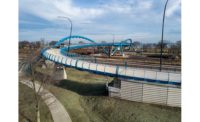The Ohio Dept. of Transportation has selected three design and construction teams that will vie to design, construct and partially finance a $330-million vehicular bridge in Cleveland, marking the first public-private partnership ODOT has undertaken since receiving authorization in 2011.
Teams selected to submit proposals for one of two replacements for the I-90 Inner Belt span include Kokosing Construction Co., with designer Michael Baker Jr. Inc.; Walsh Construction, with designer URS Corp.; and Trumbull Corp., The Great Lakes Construction Co. and The Ruhlin Co., with designer HDR Engineering Inc.
ODOT plans to select a team for the bridge, an east-bound span, by early summer, and break ground by early 2014, upon completion of a west-bound span. According to ODOT spokesman Steve Faulkner, the selected team will be required to finance project costs until 2016, when it will be repaid with funds ODOT has accrued from vehicular fuel taxes. "At that point, the project will revert to a traditional financing-and-compensation scheme," says Faulkner.
The arrangement allows the project to proceed 10 years earlier than expected, saving ODOT $89 million in repairs and maintenance to the existing span, which the selected team will demolish.
The financing provision is more typical of public-private partnerships (P3s) that require design-build entities to engage in operations and maintenance once projects are complete, says Steve Skelton, president of HOCHTIEF PPP Solutions North America, Toronto. "The arrangement is also more common to buildings than transportation," he says. "It's certainly workable, even if it's a bit unusual."
The P3 initiative is part of a larger effort to fill budget gaps for Ohio projects. In January 2012, ODOT indicated a $1.6-billion shortfall would force it to delay by decades several major projects, including the second Inner Belt Bridge.
In March, ODOT launched an Innovative Delivery Division (IDD) to identify potential funding alternatives for projects, including bridges, bypasses, interchanges and intermodal connectors. The Inner Belt project is IDD's first undertaking.
These specialty divisions "give the market confidence the owner understands the P3's risk profile and its contractural terms and conditions," notes Brad Nelson, a president at Canadian contractor PCL.
To oversee IDD, ODOT hired Jim Riley, former vice president of highway infrastructure with CH2M Hill, a consultant to ODOT.
Among other planned ventures, IDD intends to hire a design-build team to finance replacement of the Brent Spence Bridge, a 50-year-old span carrying interstates I-71 and I-75 across the Ohio River between Cincinnati and Covington, Ky. Private financing would be repaid with tolls generated by the new span, says Faulkner, who notes that Kentucky would require authorization to impose a toll.
ODOT plans to extend sponsorship programs to bridges and interchanges as well. "We have the second-largest inventory of bridges in the nation and believe a handful of them would be attractive to sponsors," says Faulkner. "We're raiding the couch for every penny we can find."


Post a comment to this article
Report Abusive Comment